Censorship
BOMBSHELL: Pfizer Exposed in Cover-up | Docs Reveal mRNA Shots Stand For “Modified”
Published
2 years agoon

Pfizer has revealed in an explosive admission that the pharmaceutical giant has been lying to cover up the fact that its so-called “mRNA” Covid shots actually “modify” human DNA.
According to newly released Pfizer papers, the “m” in mNRA does not stand for “messenger,” as we were told.
It actually stands for “mod” or “modified.”
Sharing his research on Twitter, lawyer Tom Renz exposed that the COVID-19 vaccines, widely advertised as mRNA (messenger RNA) vaccines, are in fact lab-created hybrids known as modRNA.
That’s right, mRNA is designed not to send a message within the DNA, but to MODIFY it.
Tom Renz has accused the Food and Drug Administration (FDA), Centers for Disease Control and Prevention (CDC), Pfizer, and others of misleading the world about the true nature of the COVID-19 vaccines – and waiting until after the vaccine roll-out to admit the truth about the experimental product.
In his statement, Renz claims that the widely recognized mRNA technology, allegedly utilized in the vaccines, is not what it appears to be.
“They claimed the COVID-19 vaccines were mRNA & that meant MESSENGER RNA (which occurs in life everywhere). It is NOT. The mRNA is modRNA. modRNA is a lab-created hybrid designed to create changes in your genes,” said Renz.
modRNA (modified messenger RNA) is a synthesized form of mRNA that has been altered at specific sites.
ModRNA, as described by Renz, has the potential to last longer and create permanent changes in genes. He also warns of the potential for “massive unintended consequences” in the 3300 billion lines of genetic code that make up humanity.
“Why does this matter? Well let’s start with the COVID “vaccines”. Because mRNA is a weak particle and breaks down easily with a relatively lower risk of messing with your genetics than other gene therapy products (like modRNA) that is what is always talked about in the jabs. The problem is that it is a lie,” Renz wrote on his Substack.
If you searched the word “modRNA” on Pfizer’s labeling/factsheet for health care providers administering the vaccine, it will show 21 results, GWP reports.
According to the labeling:
Notwithstanding the age limitations for use of the different formulations and presentations described above, individuals who will turn from 11 years to 12 years of age between doses in the primary regimen may receive, for any dose in the primary regimen, either: (1) the Pfizer-BioNTech COVID-19 Vaccine authorized for use in individuals 5 through 11 years of age (each 0.2 mL dose containing 10 mcg modRNA, supplied in multiple dose vials with orange caps); or (2) COMIRNATY (COVID-19 Vaccine, mRNA) or the Pfizer-BioNTech COVID-19 Vaccine authorized for use in individuals 12 years of age and older (each 0.3 mL dose containing 30 mcg modRNA, supplied in multiple dose vials with gray caps and multiple dose vials with purple caps).
Vaccination providers administering COMIRNATY (COVID-19 Vaccine, mRNA) must adhere to the same reporting requirements.
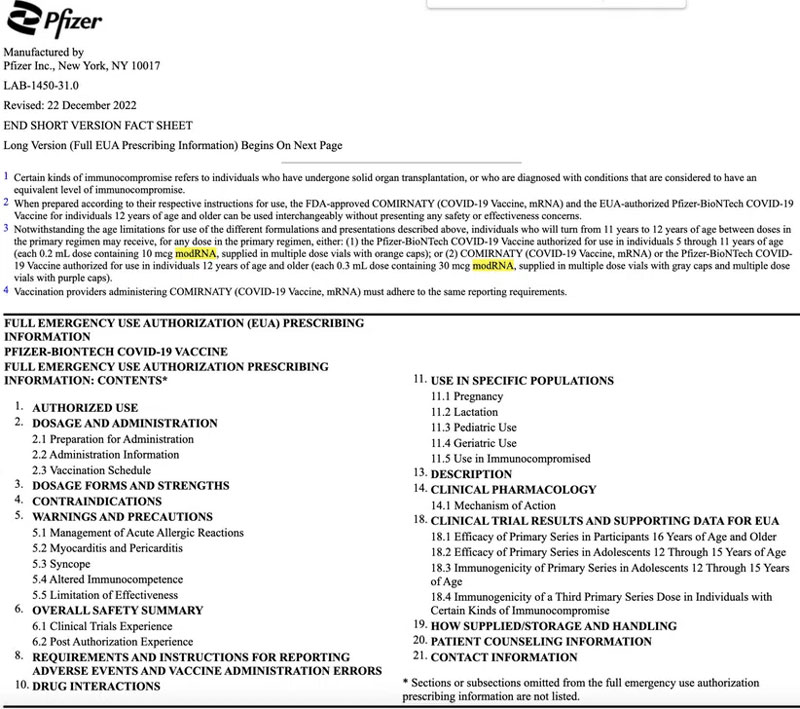
Pfizer admitted that during its clinical studies, participants aged 16 years and older received 30 mcg of nucleoside-modified messenger RNA (modRNA).
This is the main active ingredient in the Pfizer-BioNTech COVID-19 vaccine. Nucleoside-modified messenger RNA (modRNA) is a modified form of mRNA that encodes the spike (S) glycoprotein of the SARS-CoV-2 virus, the virus that causes COVID-19. The vaccine uses this technology to prompt the body’s immune system to recognize and fight the virus.
These are the side effects reported by individuals in the clinical trial after receiving the vaccine.
- Pain at the injection site (84.1%): The most common reaction, reported by over 84% of participants.
- Fatigue (62.9%): A feeling of tiredness or exhaustion was reported by nearly 63% of the participants.
- Headache (55.1%): Over half of the participants experienced headaches.
- Muscle pain (38.3%): Muscle soreness or discomfort was reported by over 38% of the participants.
- Chills (31.9%): Just under 32% of participants experienced chills.
- Joint pain (23.6%): This refers to pain in the joints, experienced by nearly 24% of participants.
- Fever (14.2%): Around 14% of the participants had a fever.
- Injection site swelling (10.5%): This refers to swelling at the location where the vaccine was injected, reported by 10.5% of participants.
- Injection site redness (9.5%): This refers to redness at the injection site, experienced by 9.5% of participants.
- Nausea (1.1%): Slightly more than 1% of participants felt nauseous.
- Malaise (0.5%): This refers to a general feeling of discomfort or unease, reported by 0.5% of participants.
- Lymphadenopathy (0.3%): This refers to the swelling of lymph nodes and was reported by 0.3% of participants.
In the clinical trial for participants aged 12 through 15 who received the vaccine, which contains 30 mcg of nucleoside-modified messenger RNA (modRNA).
These are the side effects reported by individuals in the clinical trial after receiving the vaccine.
- Pain at the injection site (90.5%): Most participants experienced pain where the vaccine was injected.
- Fatigue (77.5%): Tiredness or exhaustion was reported by over three-quarters of the participants.
- Headache (75.5%): A common reaction, with over 75% of the participants experiencing headaches.
- Chills (49.2%): Nearly half of the participants experienced a feeling of coldness or shivering.
- Muscle pain (42.2%): Over 42% of the participants reported muscle soreness or discomfort.
- Fever (24.3%): Around a quarter of the participants had an elevated body temperature.
- Joint pain (20.2%): Pain in the joints was reported by over 20% of the participants.
- Injection site swelling (9.2%): A smaller percentage reported swelling at the location of the injection.
- Injection site redness (8.6%): A mild reaction involving redness at the injection site.
- Lymphadenopathy (0.8%): Swelling of lymph nodes, a rare reaction, was reported by 0.8% of participants.
- Nausea (0.4%): A very small percentage (0.4%) felt nauseous after receiving the vaccine.
According to Pfizer, experiences and reactions reported after the vaccine was authorized for public use:
- Severe allergic reactions, including anaphylaxis: These are intense allergic reactions that can be life-threatening, though they are rare. They have been reported following the administration of the Pfizer-BioNTech COVID-19 Vaccine.
- Myocarditis and pericarditis: These terms refer to inflammation of the heart muscle (myocarditis) and inflammation of the lining around the heart (pericarditis). Both have been reported in individuals after receiving the Pfizer-BioNTech COVID-19 Vaccine.
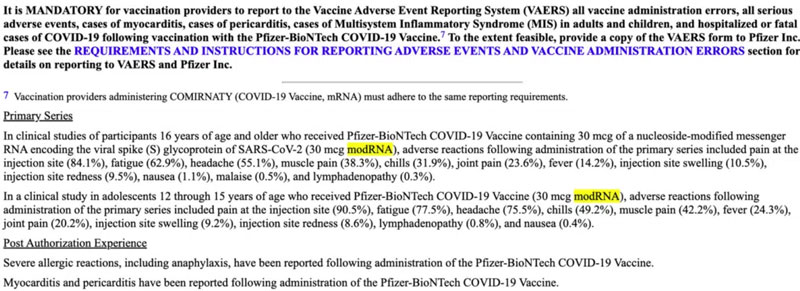
More from the labeling document:
DESCRIPTION
The Pfizer-BioNTech COVID-19 Vaccine is supplied as a frozen suspension in multiple dose vials with purple caps; each vial must be diluted with 1.8 mL of sterile 0.9% Sodium Chloride Injection, USP prior to use to form the vaccine. Each 0.3 mL dose of the Pfizer-BioNTech COVID-19 Vaccine supplied in multiple dose vials with purple caps contains 30 mcg of a nucleoside-modified messenger RNA (modRNA) encoding the viral spike (S) glycoprotein of the SARS-CoV-2 Wuhan-Hu-1 strain.
Each 0.3 mL dose of the Pfizer-BioNTech COVID-19 Vaccine supplied in multiple dose vials with purple caps also includes the following ingredients: lipids (0.43 mg ((4-hydroxybutyl)azanediyl)bis(hexane-6,1-diyl)bis(2-hexyldecanoate), 0.05 mg 2[(polyethylene glycol)-2000]-N,N-ditetradecylacetamide, 0.09 mg 1,2-distearoyl-sn-glycero-3-phosphocholine, and 0.2 mg cholesterol), 0.01 mg potassium chloride, 0.01 mg monobasic potassium phosphate, 0.36 mg sodium chloride, 0.07 mg dibasic sodium phosphate dihydrate, and 6 mg sucrose. The diluent (sterile 0.9% Sodium Chloride Injection, USP) contributes an additional 2.16 mg sodium chloride per dose.
The Pfizer-BioNTech COVID-19 Vaccine does not contain preservative. The vial stoppers are not made with natural rubber latex.
CLINICAL PHARMACOLOGY
The modRNA in the Pfizer-BioNTech COVID-19 Vaccine is formulated in lipid particles, which enable delivery of the RNA into host cells to allow expression of the SARS-CoV-2 S antigen. The vaccine elicits an immune response to the S antigen, which protects against COVID-19.
According to Epoch Times’ author, Klaus Steger, a molecular biologist who specializes in the gene regulation of sperm development, modRNA is created in a laboratory. The two—mRNA and modRNA—are completely different.
Epoch Times reported: How is RNA modified? Simply put, one of the four compounds in RNA is modified (e.g., the natural nucleoside uridine is modified to make synthetic/artificial methyl-pseudouridine). The modRNA is then: More stable (it lasts longer in the body). Less immunogenic (it evokes reduced stimulation of the innate immune system).More efficient (modRNA produces more protein than the same amount of mRNA).
The therapeutic application of modRNA in humans presents challenges and dangers. Alarmingly, modRNA contains a viral gene sequence. Upon entering a cell, modRNA takes control of the cell machinery and reprograms it to produce a viral protein—for example, spike protein.
Perhaps most astonishing is that, when creating the COVID-19 vaccines and boosters, scientists already knew that targeted delivery of modRNA was impossible. modRNA cannot be targeted to specific cells. As such, it attacks perfectly healthy cells—even beyond natural barriers like the blood-brain barrier.
mRNA and modRNA are completely different.
Since the information between the modRNA and mRNA are so limited online, and also, I am not a scientist, we asked AI to differentiate the two.
1. Basic Definition
- mRNA (messenger RNA): It is a single-stranded molecule that carries the genetic information from DNA to the ribosomes, the cellular machinery responsible for protein synthesis. It tells your DNA how to make specific proteins. The mRNA contains instructions that your body can read to create a special type of protein. This protein triggers your immune system, which then creates antibodies specific to COVID-19.
- modRNA (modified mRNA): modRNA is a man-made short-lived heterologous 5′-capped messenger RNA (mRNA), in which some nucleosides are replaced by others non-standard, naturally modified in eukaryotes (e.g., pseudouridine, 5-methylcytosine, 6-methyladenosine), or by synthetic nucleoside analogs, such as N1-methylpseudouridine. These modifications are introduced to improve stability, translation efficiency, and reduce the immunogenic response within the body.
2. Structural Differences
- mRNA: Consisting of a sequence of nucleotides, mRNA is generally not altered after being transcribed from DNA, retaining the same sequence as its corresponding DNA template.
- modRNA: Modifications in modRNA can include chemical alterations like the substitution of uridine with pseudouridine, which helps in reducing the recognition of RNA as foreign material by the immune system.
3. Applications
- mRNA: mRNA’s primary function is in the natural biological process of protein synthesis, facilitating cellular growth, repair, and maintenance.
- modRNA: Scientists have exploited the modifiable nature of modRNA for therapeutic applications, including the creation of COVID-19 vaccines. Its modified structure allows for more efficient uptake into cells, creating a more effective platform for vaccines and gene therapy.
4. Stability and Immune Response
- mRNA: Unmodified mRNA can be recognized by the immune system as foreign material, leading to degradation or triggering an unwanted immune response.
- modRNA: The modified structure of modRNA ensures that it is more stable and less likely to provoke an immune reaction, making it more suitable for therapeutic applications.
According to a peer-reviewed study published on Wiley Online Library, modRNA can cause autoimmune diseases.
Here is a brief explanation based on the study:
- Fragility at Room Temperature: Unlike DNA, modRNA is very delicate at room temperature, requiring ultracold storage and a specialized cold chain for distribution. This fragility is a critical issue with the technology. Some thermostable mRNA vaccines have been developed to address this, allowing storage at room temperature for at least a week.
- Hypersensitivity and Allergic Reactions: A significant concern with modRNA technology is hypersensitivity. The vaccines must be incorporated into PEGylated lipid nanoparticles to achieve transfection since mRNA degrades rapidly. PEGylation refers to attaching polyethylene glycol (PEG) polymers to macromolecules to aid delivery to tissues. Some individuals have been reported to have allergic reactions to PEG-containing products, which may trigger immediate hypersensitivity reactions with the vaccine.
- Types of Hypersensitivity Reactions: Beyond immediate reactions, other types of hypersensitivity reactions (such as cytotoxic, immune complex, delayed, and autoimmune) must be considered in both the short and long term after administration. These can potentially lead to various health concerns.
- Impact of New Virus Variants: The text also raises questions about how new circulating variants of SARS-CoV-2 may affect vaccine-induced protection and the potential for antibody-dependent enhancement, an escape mechanism used by some RNA viruses. These are concerns that require further study and monitoring.
- Autoimmune Diseases Consideration: There is also a mention that autoimmune diseases may occur after an external antigenic stimulus in genetically predisposed subjects, which could be a concern with modRNA vaccines.
You may like
-


Biden Officials Accused of Delaying Public Warning on COVID-19 Vaccine Heart Risks, Senate Report Alleges
-


Biden Admin Hid Info Pointing to Lab Leak Theory From Intel Agencies
-
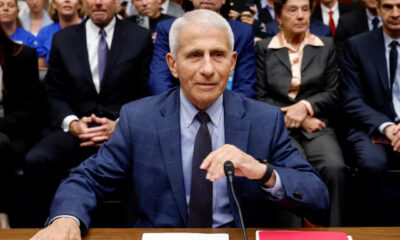

Calls for Fauci and NIAID to be Investigated for Federal Records Act Violations, Evading FOIA requests
-
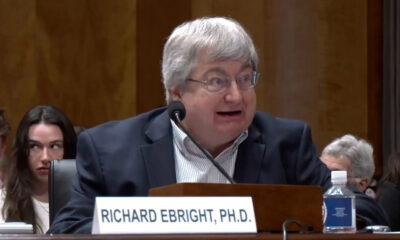

Scientific expert claims ‘zero’ evidence supporting natural origin of COVID-19
-


Kansas Sues Pfizer Over Alleged Consumer Protection Violations Related to COVID-19 Vaccine
-
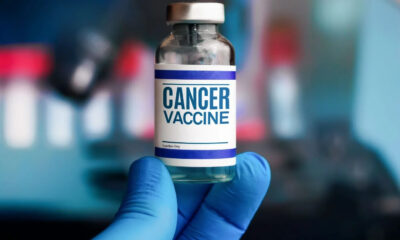

mRNA Covid Vaccine Aids Development of Cancer, New Study Finds
Biden Administration
Biden Admin Hid Info Pointing to Lab Leak Theory From Intel Agencies
Published
10 months agoon
December 31, 2024
A newly released report alleges that the Biden administration withheld information that pointed to a lab leak in China as the origin of the COVID-19 pandemic from U.S. intelligence agencies, while working with social media platforms to suppress dissenting voices challenging the official narrative. According to the Wall Street Journal, the report claims that the suppression of alternative viewpoints was part of a broader effort to control the narrative surrounding the origins of the virus, particularly the zoonotic theory that COVID-19 jumped from animals to humans.
The debate over the origins of COVID-19 has become a focal point for concerns over censorship and government influence. While some agencies, such as the Centers for Disease Control and Prevention (CDC), supported the zoonotic theory, the FBI stood apart, asserting with “moderate confidence” that a lab leak was the most plausible origin. However, despite this assessment, the FBI was excluded from an intelligence briefing for President Biden in August 2021, leading to concerns from officials within the agency about the omission of their perspective.
The Wall Street Journal’s report highlights the role of social media platforms in silencing opposing views. Public health officials and government agencies allegedly collaborated with platforms like Facebook to remove or flag content that questioned the zoonotic-origin theory. Rep. Jim Jordan, a member of the House Judiciary Committee, revealed that the White House had pressured Facebook to censor narratives contrary to the official stance.
The report also raises concerns about potential conflicts of interest. Adrienne Keen, a former State Department official, was involved in advocating for the World Health Organization’s (WHO) zoonotic findings despite criticism of the WHO’s reliance on data from China. This involvement has led to questions about her impartiality, with some critics suggesting that her work may have discredited the lab leak hypothesis to protect Chinese interests.
Domestic efforts to suppress the lab leak theory were also widespread. Public health officials dismissed the theory as a baseless conspiracy, and social media platforms removed content that raised doubts about the official narrative. The National Institutes of Health (NIH) later acknowledged funding gain-of-function research at the Wuhan Institute of Virology, which could have played a role in the virus’s development, but questions about the research were often dismissed as unscientific or even racist.
Internally, the suppression of information extended to government agencies. The Defense Intelligence Agency (DIA) and the National Center for Medical Intelligence (NCMI) reportedly concluded that the virus was genetically engineered in a Chinese lab, but up to 90% of their findings were excluded from official reports. The DIA’s Inspector General has launched an investigation into the suppression of these critical contributions.
As more evidence supporting the lab leak theory has emerged, support for this explanation has grown. In 2023, the Department of Energy joined the FBI in concluding that a lab leak was the most likely origin of the virus. Former Director of National Intelligence John Ratcliffe has also supported this view, citing the intelligence community’s access to the most information on the matter.
The growing consensus around the lab leak theory raises questions about why it was suppressed for so long. Critics argue that the censorship and control of narratives not only delayed crucial inquiry into the origins of COVID-19 but also undermined public trust in the institutions tasked with managing the pandemic.
This case highlights broader concerns about government-directed censorship and its impact on free speech. The suppression of alternative viewpoints, especially when it comes to critical issues like the origins of a global pandemic, has far-reaching implications for public discourse and democratic principles.
Big Tech Censorship
Elon Musk Threatens Legal Action Over ‘Advertising Boycott Racket’ Targeting Right-Leaning Media
Published
1 year agoon
July 11, 2024
Elon Musk threatened legal action on Thursday against an alliance of major companies, accusing them of participating in an “advertising boycott racket” that has exacerbated a revenue decline at his social media platform, X.
Musk, who acquired the company formerly known as Twitter for $44 billion in 2022, made the announcement in response to a video of Daily Wire founder Ben Shapiro’s Congressional testimony. Shapiro’s testimony addressed alleged collusion by advertisers against right-leaning platforms.
“Having seen the evidence unearthed today by Congress, X has no choice but to file suit against the perpetrators and collaborators in the advertising boycott racket,” Musk wrote on X. “Hopefully, some states will consider criminal prosecution.”
Elon Musk’s threat follows Shapiro’s testimony before a House Judiciary panel during a hearing entitled “Collusion in the Global Alliance for Responsible Media (GARM).” GARM, an initiative by the World Federation of Advertisers (WFA), aims to tackle harmful content on digital media platforms and its monetization through advertising. WFA’s members, including Disney, Coca-Cola, Toyota, and Hershey, represent nearly 90% of global advertising spending, amounting to almost $1 trillion annually.
During the hearing, Shapiro and lawmakers focused on the conduct of GARM chief Robert Rakowitz. An interim House staff report highlighted Rakowitz’s questionable behavior, including an internal email from February 9, 2023, where Rakowitz appeared to boast about X being “80% below revenue forecasts” after GARM’s challenges on brand safety issues. Rakowitz claimed the email was a “self-effacing joke.”
The House report also unveiled biases against conservative media. An email exchange from October 2021 between Rakowitz and John Montgomery, EVP of global brand safety at GroupM, the world’s largest media buying agency, discussed blocking certain news outlets like Fox News, The Daily Wire, and Breitbart News. Montgomery admitted, “As much as we hated their ideology and bulls—t, we couldn’t really justify blocking them for misguided opinion,” but noted that they monitored these outlets closely and acted when they “crossed the line.”
In light of these revelations, Musk has urged for both civil and criminal repercussions. “Hopefully, some states will consider criminal prosecution,” Musk stated, highlighting the severity of the alleged collusion.
Representatives for GARM, GroupM, and X did not immediately respond to requests for comment on Musk’s post. Shapiro, in his opening statement shared by Musk, called on Congress to address what he termed as “censorship cartels like GARM and executive branch agencies” that oppose conservative views. The subcommittee is currently evaluating whether existing civil and criminal penalties, along with antitrust law enforcement efforts, are adequate to deter anti-competitive collusion in online advertising.
This development underscores the growing tension between major tech platforms, advertisers, and political entities over content moderation and free speech. Musk’s aggressive stance signals a potential legal battle that could have significant implications for the future of digital advertising and media bias.
As the situation evolves, the spotlight remains on whether the legal threats will materialize and how they might influence the practices of global advertisers and media platforms.
Censorship
Journalist threatened with jail for publishing trans shooter Audrey Hale’s deranged journal writings
Published
1 year agoon
June 16, 2024
A journalist from the Tennessee Star is being summoned to appear in court and faces jail time for publishing journal writings of transgender shooter Audrey Hale, sparking freedom of the press concerns.
The article revealed that Hale, who shot and killed six people at the Covenant Elementary School in March 2023, wrote about her ‘imaginary penis’ and how she would ‘kill’ to get puberty blockers weeks before her horrific act.
For more than a year, Nashville Chancellor I’Ashea Myles has been presiding over a public records case wherein the plaintiffs are suing to get the right to release documents related to the shooting. Families of the victims are on the exact opposite side, trying to bury the documents and keep them out of the public eye.
But since the case is ongoing, Myles is claiming that the Tennessee Star may have published ‘certain purported documents and information’ that should have remained under seal.
At Myle’s request, Tennessee Star editor-in-chief Michael Patrick Leahy will appear in court Monday to explain why his news outlet didn’t violate the court order.
Michael Patrick Leahy, CEO of Star News Digital Media and editor-in-chief of the Tennessee Star
Nashville Chancellor I’Ashea Myles, who’s been presiding over the public records fight over Audrey Hale’s manifesto
Michael Patrick Leahy, left, is the CEO of Star News Digital Media and editor-in-chief of the Tennessee Star. Nashville Chancellor I’Ashea Myles has ordered Leahy to appear in court because of the Star’s reporting on Audrey Hale’s journal writings.
Leahy, who also serves as CEO of Star News Digital Media, publisher of the Tennessee Star, claims his outlet has done nothing wrong throughout the course of its reporting.
The Star has claimed a June 5 story didn’t actually publish any of the leaked images of her journal entries but just snippets from it, reported the Associated Press.
‘This could raise First Amendment issues,’ said Deborah Fisher, Tennessee Coalition for Open Government’s executive director.
Jeff Clark, a former US attorney, also sided with Leahy, saying he was just doing a journalist’s job and getting crucial information about the shooting.
Leahy ‘is in jeopardy in Tennessee state court for trying to get out the Covenant Killer Audrey Hale’s “manifesto.” And presumably other info about her,’ Clark wrote on X.
‘The American people deserve to know the details of how Hale was radicalized by the trans agenda. And the victims’ family especially deserve to learn that information.’
Hale, 28, was a transgender artist, who identified as a male named Aiden, shot her way into the Tennessee elementary school in March 2023, killing three adults and three nine-year-olds, before responding officers killed her.
Officers found her writings in the car she drove to the elementary school, and the Star reported on ‘nearly four dozen images of notebook pages written by Hale’ provided by a source familiar with the investigation.
Hale wrote about anger toward her parents, how she hated her conservative Christian upbringing, and how she had suffered because hormone blockers were not available when she was a child.
One of her entries was ‘My Imaginary Penis’ and included a crude drawing, according to the Tennessee Star.
‘My penis exists in my head. I swear to god I’m a male,’ Hale wrote in the papers.
She then wrote about her desire to have a penis so she could have sex with a woman, in her assumed identity as Aiden.
She wrote about how using that name on a job application for a delivery position led to issues with the company’s background check.
Hale also said that being raised as a girl was ‘torture.’
She worried that high school classmates would call her ‘dyke or a f*‘, she wrote.
That all changed when she learned about transgenderism in her early 20s.
‘I finally found the answer — that changing one’s gender is possible,’ wrote Hale.
After the Star’s reporting throughout June, the Nashville’s Metropolitan Police said in a statement that ‘it is concerned about the alleged leak, and we, like others, would like to know from where it came.’
Immediately following the shooting, Nashville’s police chief John Drake said Hale’s manifesto as well as the hand-drawn maps found in her car would eventually be made public.
Now, despite the leaks, both city police and the FBI say the material shouldn’t be released because the information could damage any potential investigation.
In a statement to The Center Square, Leahy said he plans to defend his and his outlet’s rights to publish relevant information about the shooting.
‘Yes, I intend to appear in court on Monday at 11 am, along with my attorneys, Nick Barry with America First Legal and Daniel Horwitz, a nationally recognized First Amendment attorney based here in Nashville,’ Leahy told The Center Square Sunday.

Tim Walz asked Minnesota assassin to kill Senator Klobuchar so he could take seat, FBI letter claims

ChatGPT use linked to cognitive decline, MIT research finds

Kamala Harris Allegedly Covered Up Biden’s Mental Decline, Democratic Source Says

Biden Administration Lost Track of Billions in Seized Crypto

Tim Walz asked Minnesota assassin to kill Senator Klobuchar so he could take seat, FBI letter claims


You must be logged in to post a comment Login